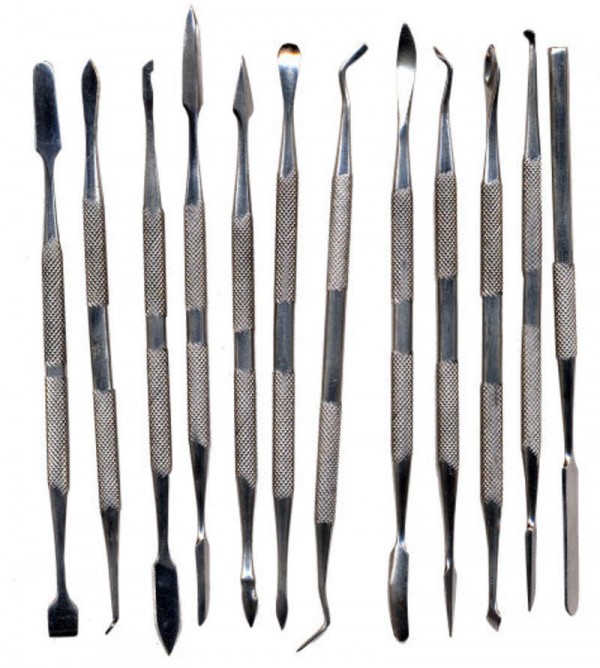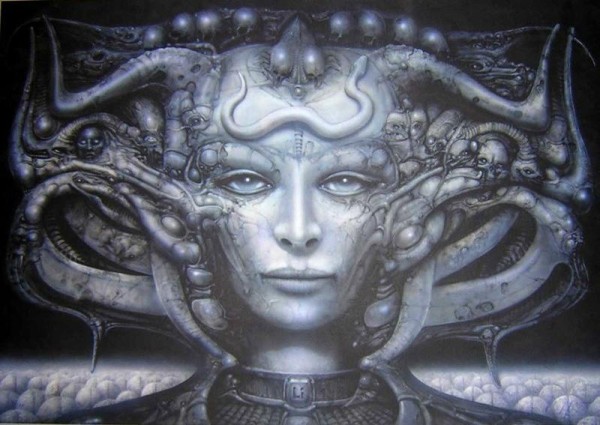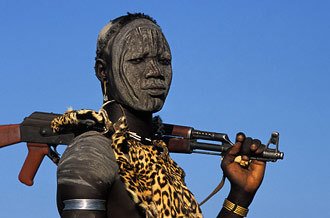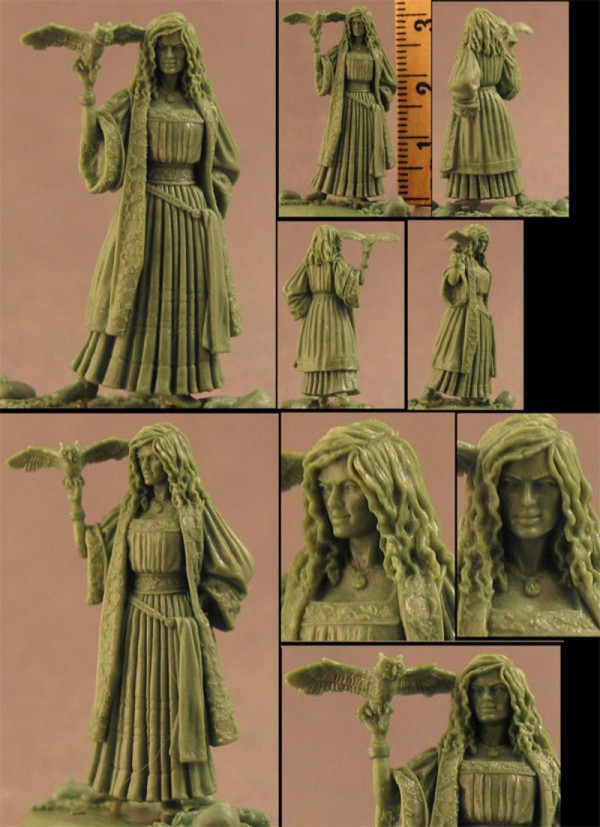There’s a saying, which is often said to be a Chinese curse: “May you live in interesting times”. Whether it’s a true Chinese curse or not, it doesn’t matter. But one thing is sure – we’re living in interesting times, indeed. Many new technologies made it to our lives and hobbies. Digital sculpting is one of them…
Many people are sceptical to innovations and refuse to treat them on par with the old methods.
Just like with most new technologies, there are as many people fascinated with the new possibilities as others – criticizing it. Not only being critical and sceptical about it, but also refusing to treat it on par with traditional sculpting. And we’ve had an interesting discussion about digitally sculpted miniatures on our miniature painting forum, but let’s start from the very basics.
What is digital sculpting?
You surely know what traditional sculpting is: The sculptor takes a lump of putty or clay and shapes it with his hands and/or sculpting tools. You know the kind of tools used for sculpting, right? You surely do.

Now with digital sculpting, the artist forgoes his “physical” sculpting and tools to use a computer and create a “virtual model” with it. You must have heard about 3d modeling – you can see digital 3d models everywhere: in movies, in computer games, on digital artwork, on posters, in advertisements… Often it’s difficult to tell if the object or person was a real one or is it only a virtual creation.
Now one can create such a 3-dimensional model and then “print” it, using one of many 3-d printing services. Or maybe create a mold and produce copies of it. It doesn’t really matter – the clue is that a virtual creation is turned into a physical, tangible object. In our case: a miniature. That’s what digital sculpting of miniatures is all about.

I bet you see the difference: “Traditional sculpting” creates a physical object from the beginning, and “digital sculpting” creates a virtual model first, which is given a physical form in the next step(s). And what are the consequences of this difference?
Traditional vs digital sculpting
Digital sculpting can use many benefits of working on a virtual object, many that we know from inage editing software – like “undo”, “copy-paste”, easy texturing, etc. When a sculptor makes a mistake, he can press “undo” and correct his mistake easily. When he wants to create another arm, sword, head, etc. – he can use “copy/paste” and modify the newly created copy. He can also “stamp” textures onto surfaces of his models. There are many many other options in popular 3-d modeling software, but I only wanted to give you a quick insight into the choice of tools the sculptor may use in his digital sculpting.

On the other hand, traditional sculptors have similar options, but they’re not as easy to use as in digital sculpting. Sure, he can “undo” his mistakes – by cutting off, sanding off, or scratching off the parts he’s not satisfied with. It takes more work than pressing a button, but can be done. Of course, he can “copy and paste” an element he sculpted: he can create a mold and cast a few copies, or maybe create a quick print in greenstuff… But it’s more difficult and time consuming than pressing Control+C Control+V. And yes, he can also stamp textures: create a small textured “stamp” and press it against surfaces before they’re cured. But it’s not as easy and convenient as doing it the digital way.
So what? Does it make a traditional sculptor a better artist (or craftsman) than a digital sculptor?
Text processor vs pen
Is a miniature good because of its creative concept or the tools chosen by the sculptor?
Let’s think about a poet who writes a poem, or a novellist writing a book. Many of them moved on to using computers and text processing tools now. But doesn’t it make their art less impressive? They can use copy-paste, undo, and spellcheckers now. Their friends using pens or pencils do the same, but do it the harder way. Does it make their art better because they had to put more effort into it.
Or is it more about creativity than the choice of tools?
Wait, there’s another example, because the first one was a bit too controversial. Let’s take a painter with oil paints and canvas, another one with a photo camera and traditional darkroom plus a choice of retouching tools (traditional, not digital), and another one with photoshop and computer. They all create images, visual art. They all can create pictures of landscapes.

But is the painter more of an artist than the photographer? And the digital artist less of an artist than the painter?
Or do they create different kinds of art? Although they are all kinds of visual art, they’re all pictures, they’re difficult to compare at all…
Errare humanum est
Or: “To err is human”. Errors and mistakes are a part of our lives and also of our creations. Some say, that imperfections make works of art even more impressive and admirable. You must have read many comments that digital sculpting creates sculpts which are too perfect, too clean, too artificial. That they lack the human touch, the personal touch of the sculptor, which is given by traditional sculptors to their works. Do you agree with this opinion?

When you take a look at traditionally sculpted miniatures, many of them bear marks of some sculpting imperfections. Sometimes surfaces are not perfectly smooth, details not perfectly symmetrical, and shapes not perfectly modeled. And that makes them special, that makes them unique and gives them the magic touch of the sculptor.
Is it the same with digital sculpting? If people complain it lacks the imperfections of traditional sculpting by the sculptor’s hands, maybe it is the case? Or maybe it’s simply the lack of mastery of digital sculptors? Maybe there are many great traditional sculptors already, because this art (or craft) has many years of tradition already, but digital sculpting is fairly new and people use it not because of the possibilities of creating great sculpts it offers but because of the benefit of saving time and thus increasing productivity? And when time is your priority, it’s difficult to pay more attention to quality.
It’s just a tool
So is digital sculpting a completely different kind of art/craft, or is it only a different tool for sculptors to use. If it wasn’t for progress and innovations we might be still sculpting our miniatures in clay or chiselling them from stone. But now we have many kinds of putties, all with different properties. We have modern casting facilities, we have precise sculpting tools. So maybe digital sculpting is the next step on the same path? Some will move on, some will stay with the techniques they’re more familiar with.

Just think about painters. Some are still painting their paintings with brushes, some moved on to airbrushing. I bet it was simiar when somebody invented a brush. Some traditionalists must have complained that painting with brushes is not real art, because it’s taking a shortcut, and they kept painting with their fingers or wooden sticks. 😉
Just like every tool, digital sculpting has its disadvantages, too.
And just like with every tool – digital sculpting has its disadvantages, too. You only get to see the physical object when it’s printed. Until then you only see a virtual image of your sculpt. And you see it on a 2-dimensional screen. Now recall all the complaints that there’s no way of depicting a 3-dimensional painted miniature on a computer screen and a flat image. Translate it to sculpting and you know what I am talking about.
Then there’s the frequent complaint about lack of sharpness of digitally sculpted miniatures. Is it a matter of the sculpting or the printing process? I don’t know, but it seems many companies fail to get it done properly for any reason. So as you can see digital sculpting is not the perfect solution to every sculptor’s woes.
Next generation or degeneration?
Will the transition to digital sculpting result in decrease of sculpting skills?
If we think about digital sculpting along the lines of “next generation of sculpting tools”, we may start to worry if it won’t start a process of degeneration of sculpting skills of sculptors who move on to the new tool. Just like many airbrush painters wouldn’t be able to achieve smooth blending on their canvas using only traditional brushes. And just like many photographers would be unable to create a realistic portrait in the way artists of old did it – drawing or painting it. But do they have to?
Do photographers really have to prove they’re skilled painters? Do people who create great art using airbrushes really have to prove their skills with brushes? And do digital sculptors really have to prove their skills with traditional tools and putties?

I say: no, they don’t have to, but their art shouldn’t really be compared with traditional art as far as technical perfection goes. When you compare creativity – feel free to do so, but technical aspects are hardly comparable…
Clash of the titans
I am yet to see a digitally sculpted miniature which will impress me more than some traditional miniatures did.
Now there’s a good question: If we compared a great digital sculptor with a great traditional sculptor, would they be able to create comparable works? I mean: equally impressive and appealing to us, miniature painters? I must say I am yet to see a digitally sculpted miniature which will impress me more than the best miniatures sculpted in the traditional way.
There are many great sculptors, who work in the traditional way. Many that I really admire. Kev White with his characterful models and realistic proportions, Tom Meier with his unbelievable skills at detailing his sculpts, Raul Garcia Latorre with his recognizable style, and many more…

I have seen many great digital 3-d models (many were really awesome!), but I don’t know of any digitally sculpted miniature which would make me go “wow” as much as many traditional sculpts did. But maybe you have seen such miniatures?
Time will tell…
Now we don’t know which way it’s going to go in future. But we can be sure we’re witnessing and experiencing beginnings of a new trend in our hobby. Digital sculpting made achieving many results so much easier, that it’s going to be pursued for many years to come. But will it completely take the place of traditional sculpting in our hobby?
It is quite natural to look for more optimal tools, ones which will allow you to improve your creations and which suit your needs and style better. It’s a natural process, and it can’t be avoided. But let’s think: should it?

I am really curious what you think about the “digital sculpting vs traditional sculpting” subject. Why don’t you share your comments with us. I am sure they will add many new facts to the topic. Thanks in advance!
— Mahon


Ive seen alot of good miniatures digitally sculpted, probably because digital sculptors have primarily come from a traditional background.
Ive seen far too many really crap miniatures sculpted traditionally to say its better than digital. Its all about the hands the tool is in, not the method used. if you cant sculpt you wont be able to create good digital sculpts, so really your just talking about different tools.. as traditional sculptors argue over the best putty, one says greenstuff one says procreate… now another brand of putty is on the market, so we argue over mudbox or z brush. at the end of the day its the hands of the artist that make the difference.
well yes end no – ther is alvays factor how it look like in RW – all Digital sculpt that have to be turned to mini must pass printing process end not all things looks good after printing , beside i know a digital sculptor who do marvelous things in 3D but when you give him a Clay he is as good as 3 y old kid – he whas a digital sculptor from begining end never lerned how to work with real things – end that shows in prints – his colegues that comes from old tech end then advenced to digital thinks in difrent way then him – they sculpt in 3d but all time thinking about RW end how it will look in RW …
so to the point – whats better … hard to tell but after all thing that count is how idea translated to rality end atm a “clasical” sculpting do it better (end i consider that as an imperfection of D3 tools is to blame on – it is after all 2d not 3d end then is printing proces – imperfect 1 – so time will tell 😀 )
Artists are entitled to create in whatever medium they want. If you start nit-picking, then you’d might as well say that photographers aren’t creating art, just stealing an existing image, and you might as well say that miniature painters are cheating because we’re applying paint to an already 3D surface, instead of creating 3D on a 2D surface.
One thing I do have to say is that if a 3D Sculpting is to be casted/printed, a good sculptor needs to keep in mind the final medium. Your picture of the loss of detail after casting is a good example of this – a 3D sculptor who knows their works are intended to be printed needs to be aware of what detail they’ll lose getting to the finished product. This means they need to sculpt to a lower standard and plan accordingly so that the final sculpt doesn’t look like it’s missing anything.
It would be like if printers were only capable of 8-bit, and a digital artist (who knew a commission was to be printed) made a beautiful image in Photoshop, which looked like crap after printing… Same thing – why make a high res 3D sculpt, knowing printers or castings will fail?
Another example would be a wordsmith, who “dumbs down” a written work so that laymen would understand it. A scientist giving a speech to general populace would have to use simpler words and descriptions.
hmm, actually thinking about this, here’s a great real world example of my point:
http://www.totalfilm.com/news/fourth-hobbit-production-blog-arrives
In filming The Hobbit, they found their 3D tech to pickup colours differently… It meant that all costume, makeup, scenery, etc. had to be overcompensated for. So, if you’re looking at the scene in real life, things look wrong – but on camera, the colours appear properly. You could be the greatest makeup artist in the world, but if your reaction to that kind of issue is to shrug and say “not my problem” instead of compensating for what’s needed in the final project, you’d get canned.
Thanks for your comments, guys.
I think it’s a general consensus that most of us consider it just another tool for miniature makers to create their works with. And just like every tool – it has its advantages and disadvantages, its learning curve, its limitations, etc.
Some people on TMP message boards commented that digital sculpting will make creating new miniatures more available for people who are less gifted with artistic talents. As much as some knowledge and experience with traditional sculpting techniques will help, it’s not necessary. But I think it will show if one has some experience in this field or not. But just like with every kind of creative activity, there will be masters, artists, skilled craftsmen, and mediocre (or even poor) guys. You can’t replace talent with a tool, but you can choose the most suitable tool for your needs.
You may wish to check the discussion on TMP out and maybe share your remarks here?
Thanks again and hope to read even more from you 🙂
Thank you, Mahoń for such interesing article!
I don’t really care about process of creating miniatures, I just want to buy nice figure.
I remember writing an essay about traditional 2d vs 3d animation back in the late 90’s while in school. Will 3D animation take over the animation industry? Well, it ultimately did. If you realize, it’s not much different from this subject. When this technology becomes widespread and affordable, most miniature companies would engage 3D sculptors eventually. All we are going to see is the merger of traditional sculpting and digital sculpting. You need a great understanding both traditional skills and technological skills to be successful. It’s a matter of not falling behind when the industry is changing and the world is constantly in motion.
I just read this article, and one thing shock me a bit : The way you talking about the less-technical abilities necessary to obtains a good result in digital sculpting, compare to the more technical and complex, necessary skills to sculpt it the traditionnal way.
Before continue writing, I advertise you for my bad english… 😉
Now my objections is that’s the technical abilities that you need, and the time, to do a digital sculpt is comparable to the traditional sculpting time and skills that you need.
The computer it’s a powerful tool, able to copy/paste, stamp textures, etc… fast and “easily” when you have to skills to control it.
The difficulty with digital sculpting is the interaction between the sculptor and his creations. In traditional sculpting, you see and feel immediately the putty, the miniature shape; even a beginner can understand how you can do any complex details that you want. You take the putty, prepare it, take the perfect tools and if you have the skills to do it…
Now imagine a beginner behind his computer’s screen. He want to sculpt a miniature, but he can only see it in a flat way, that’s right…
But in front of him is hundred, thousands of differents buttons, functions… he simply don’t know WHERE to begin. In traditional sculpting, when you begin, you KNOW that you have to take your putty/polymer clay, then to get tools and practice. You know how your hand will follow your brain d you creativity : by physical practice.
But the interface of a 3D-modeling software is much complex and hardly understandable then a putty and some tools.
Of course, the skills to get in both ways are technically equal for me. Only the artistic instinct can’t guide you in a 3D-modelling software, but he can guide you if you choose the more simple “interface” than a putty and some tools are.
About the evolutions of sculpting, I hope that both ways will be combined : Imagine a miniatures created by the scan of a traditionnal sculpting, with digital details… :O
That’s my opinion about that.
I think what I wrote was more like: whatever tool you use, it requires particular skills, it takes time to master, has its advantages and disadvantages. Use whatever tool suits you best, as what we want is good results, not just knowing you chose the most difficult path to your target.
Anyway you made a very good point about being unable to see your model in 3d when you’re sculpting digitally. That is a difficulty that surely takes some time to get used to.
Thanks for the comment and another interesting point in the discussion!
Hi. My name is Claudio and I’m starting to find my way on this miniatures/figures world. I’m a ZBrush and Blender user, and I have a log experience with 3d software, so digital sculpting was my natural choice. But the problem here is: with digital sculpting you need to rely on sources and 3rd. part that won’t depend on you, like 3d printing. Unless you buy a very expensive 3d printing hi-res machine, you need to wait long production schedules, high prices shipping, import taxes or just depend on the good-will of local facilities, only interested in big companies’ market.
I am really considering to learn traditional skills; I know I’ll throw awy years of 3d experience and an investment on 3d software, but it’s the only safe way I see, now…
You seem very in favour of digital. As a traditional sculptor of minis i am worried. I have no skills when it cimes to digital sculpting and found it frustrating. Once again a case of tech killing another job. I think it willbtake over completely so i should just give up now. I dont judge people fir doung it u cant stop progress and they look great its just a fucking kick in the teeth. Peace
Printing of digital sculpts is advancing every day, within a year or two, resin home printers will give better results then traditionally cast miniatures, digital is absolutely the future for minis. There is nothing bad about progress, and nothing “charming” about holding on to the old ways. There’s a reason we’re driving cars and not using the horse and buggy…